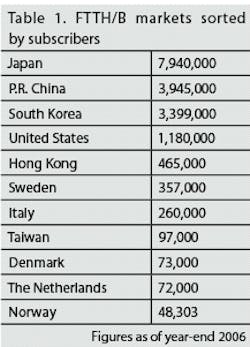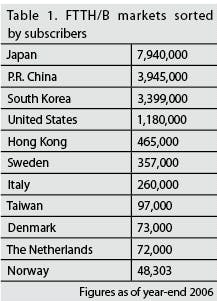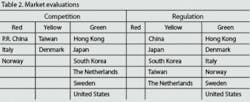FTTH Council ponders factors behind optical access acceptance
by Stephen Hardy
This past July, the three FTTH Councils (one each for the North American, European, and Asian markets) jointly released a study that detailed the 11 markets around the world in which FTTH penetration had exceeded 1% of households. The presidents of the three councils subsequently offered the assembled media at the North American council’s recent FTTH Conference, held in Orlando, FL, the first week of October, a look behind the study. The executives not only discussed the methodology used to identify the markets, they also offered opinions about the competitive and regulatory environments in each of the markets. The discussion potentially offered a glimpse into what today’s larger FTTH deployments indicate about the factors that make a hospitable environment for optical access technology.
The rankings released in July are shown in the figure. As revealed in October, each council worked with a different market research firm to derive its figures. Ovum RHK assisted the FTTH Council Asia-Pacific, IDATE teamed with the FTTH Council Europe, and the North American FTTH Council turned to its longstanding partner, RVA LLC. They collectively agreed to limit their study to networks that bring fiber all the way to the customer premises, which means either FTTH or fiber to the building (FTTB). Thus, partially optical variants, such as the fiber-to-the-node and to-the-curb architectures popular in North America, fell outside of the study’s scope.
Not surprisingly, the top three markets-and five of the 11-are Asian. While the fact that Japan, for all the attention it has drawn, achieved only the Number 3 ranking might raise eyebrows, the realization that these rankings are based on the percentage of penetration-derived by dividing the total number of FTTH/FTTB subscribers by the total number of households-and not the subscriber total explains a lot. For example, the People’s Republic of China has the second greatest number of subscribers (behind only Japan) among the 11 markets. However, that subscriber total doesn’t have a comparatively significant impact in terms of penetration percentage when the country’s 350.4 million households are considered.
In this vein, a ranking of the 11 communities by total subscribers appears in Table 1.The fact that FTTB architectures are predominant in the top two markets and in five of the first 10 also invites commentary. It would be natural to conclude that FTTB architectures deployed in markets that feature high population concentrations in urban centers dominated by apartment complexes-and certainly such a description fits Hong Kong, for example-would make it easier to boost penetration percentage. However, Michael Render, president and chief analyst at RVA, said in Orlando that his research indicates that income level has a better statistical correlation to optical access deployment than population density.
The competitive and regulatory environments are two other factors frequently cited as major influences on FTTH/B adoption. Therefore, one would expect the councils’ perceptions of the competitive and regulatory aspects within their territories to provide a test case for the amount of influence these two factors wield around the world.At the October press conference, the councils revealed that they had evaluated the competitive and regulatory conditions in each of the 11 markets via the popular traffic light motif, with red denoting a hostile or unhelpful situation for FTTH/B, yellow a mixed or neutral environment, and green a generally favorable climate. “There was considerable discussion among our International Advisory Group to come to some level of agreement, but the results represent the region’s assessment,” says Joe Savage, president of the North American FTTH Council, in describing whether each council used the same criteria to evaluate their regions.
Perhaps the subjective application of red, yellow, and green hues to describe conditions that are themselves subjective is the reason, but if one were to rate the evaluations for their ability to illuminate global trends, they’d likely receive a yellow. That’s because the evaluations produced a distinct mix of color. Neither competition nor regulation earned a green in more than six of the 11 markets (see Table 2).Overall, a hospitable regulatory environment might be considered more necessary than competition based on the numbers. As Table 2 illustrates, none of the 11 markets operates in a regulatory environment considered bad enough to earn a red designation. However, three of the 11 markets enjoy so little competition that they received red marks. It is perhaps relevant that two of these, Norway and Italy, are balanced by a regulatory environment that earned the laudatory green.
The regulatory environment in the United States earned a green as well (as did the competitive landscape). “The U.S. is clearing out the regulatory barriers to service provider operation of FTTH networks,” according to Savage. “With the favorable FCC Triennial review decision in 2004 and the FCC 2007 video franchise rule-making, national regulations are aligning with accelerated broadband and FTTH deployment. Now that more than 50% of Americans live in states with streamlined video franchise processes, local governments are also coming into alignment.”
The councils expect to release an updated version of these rankings early next year at the FTTH Council Europe’s annual conference, to be held in Paris February 26-28. In speaking of what the future may hold, European Council president Joeri Van Bogaert said in October he could foresee other markets in his territory attaining in the relatively near future the 1% penetration rate necessary to make the list. He pointed to France, Spain, and Switzerland as the most likely candidates. At the October conference, Roland Montagne, director of broadband practice, IDATE, agreed that France looks like a good bet. He also highlighted Spain and the United Kingdom as possibilities.
In Asia, Shoichi Hanatani, FTTH Council Asia-Pacific president, expressed doubt that any new 1% markets would appear in his region within the next year. Lynn Hutcheson, who spoke for Ovum RHK, seconded that assessment, although he noted that Singapore has become the most aggressive of the emerging Asian markets in its FTTH/B activities.
Stephen Hardy is the editorial director and associate publisher of Lightwave.



